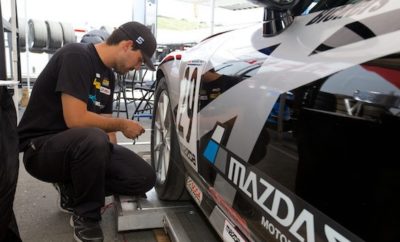There are several ways to determine if your suspension alignment is correct. One is certainly driver feel – are you getting the turn-in response you want? Is the amount of understeer or oversteer just right? Another is lap time; going faster is almost always a sign that whatever change you made is a step in the right direction (though, there are other variables). The third method, a more scientific approach that can rule out other factors, is tire temperature.
According to Ken Payne, the Motorsports Technical Director for BFGoodrich® Tires, which supplies the rubber for the Idemitsu Mazda MX-5 Cup presented by BFGoodrich® Tires as well as many club racers, taking temperatures across the tire can help determine both proper alignment and pressure. Taking temperatures with a probe pyrometer, as soon as your car comes off track, on the inside shoulder, center and outside shoulder can give you a lot of useful information.
“What you’d like to see is a nice progression across the tire,” he says. “If you could have an absolutely perfect situation, it would be an equal temperature across all zones of the tire. But what you want to see is a gradual progression from inboard to center to outboard. If you’ve got a lot of camber on the rear axle, which may be an optimum setup, you may tend to see the inboards running a little warmer and it gradually gets cooler from the inside to the outside of the tire. The opposite is usually true on the front where the outside shoulder is getting worked pretty hard in cornering.
“On the order of a 15-20 degree spread is not unreasonable. If you see extreme differences – say, outboard shoulder is 40 or 50 degrees higher – you might be looking at getting some more camber to make the inside work a little harder. Or if the inside is working disproportionally higher, you might need to take a little bit of camber out of the setup. If you consistently see one shoulder on the front tires running hot, inboard shoulder, it may be that you’ve got a little too much toe in. It’s a great tool, particularly in a club racing setting.”
Payne says it’s important to get temperatures as quickly as possible and with a probe pyrometer to ensure accuracy. If you don’t have a crewmember, find a buddy from another race group and have him take your tire temperatures, than reciprocate when he’s on track. If you can’t work that out, even after a few minutes of coming off track, the temperatures can still provide useful data, depending on ambient temperature and the surfaces the car’s been driven over between track and paddock. Similarly, if you don’t have a probe pyrometer, an infrared temperature gun will get you in the ballpark.
The other thing tire temperatures will tell you is if you’re running the proper pressure.
“If it’s a case where you measured the temps and found the inboard and outboard are almost exactly the same, but center is much lower, that probably indicates that you have the tire underinflated. The opposite effect would be overinflated where it gets to be more of a balloon shape and the center is doing more of the work, so you see the centers are running hot and the shoulders are running relatively cool,” Payne says.
Want to know about getting the most life out of your tires? Payne has some advice about that, also.


 ACCESSIBILITY
ACCESSIBILITY